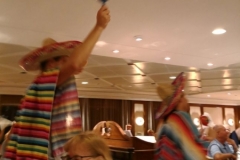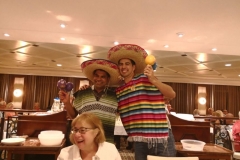https://en.wikipedia.org/wiki/Port_Chiapas
Well, I have just posted the blog on Cabot San Lucas and here I am already getting ahead by preparing my next.
My Navy mates would understand the long hours at sea. Not that there isn’t anything to do onboard it’s just that you can only play so much Trivia, see so many shows and eat so much food. Food! The quantity and quality is huge. But I suppose I will just have to grin and take the hit for the team.
After our day at the wonderful Cabot San Lucas both Shane and I slept well the night we sailed. Over the last 2 days at sea we have rested and are ready to tackle our second port, Puerto Chiapas, Mexico tomorrow.
(2 days later…) It is now Monday 21st of May, or so I am told. Time means little when you’re retired and living the dream and we certainly are doing that. We feel so lucky but this is what we have worked, skimped and saved for. But I digress. Yesterday we visited the unscheduled port of Puerto Chiapas, the most southern port in Mexico. I say ‘unscheduled’ because the ship’s track was originally planned to take us to Nicaragua however after departing Los Angeles the ship was notified “civil unrest” in the country and we were rerouted to Puerto Chiapas.
PC was happy to see us. They only receive about 2 cruise ships each year and are happy for the income that we provide. Despite the few ships they have created a very pretty entrance port with manicured gardens, a huge souvenir and tourist information ‘hut’ and a dockside club/café/pool that we noticed the ship’s company were keen to get to. Manoeuvring the Pacific Princess down the narrow channel, turning us around and berthing alongside a dock unfamiliar to you is quite a feat and our Captain did a fine job without the aid of tugs.
Once alongside we were guided to a bus to go on our hastily arranged tour to the nearby city of Tapachula followed by a visit to a museum/planetarium then on to Izapa to see some ancient Mayan ruins. Being Sunday the traffic was quiet by local standards and we were shown the city square, town hall and the earthquake damaged museum. We then had 20 or so minutes to wander the markets which held several unique twists on the ‘universal’ markets we’ve seen so many times. Food, produce, clothing, toys, gadgets all available for a few pesos. The most notable point of interest is the bright colours of the textiles. Some items are almost fluorescent but highly sought after.
no images were found
We ended our stroll at the bus where our guides were handing out free bottles of Pepsi or water to combat our dehydration from the heat and humidity. Then we were underway again to Izapa. But first a stop at the Planetarium to watch a tribal “Jaguar Warrior Dance”. (Once I have a reasonable internet speed I will upload a video of this dance but for now I have to hold it back.) In the Planetarium we watched a short movie in the planetarium on how the Mayan calendar came to be. Considering the complexities of the celestial world we live in the Mayans are to be marvelled at for their brilliant observational recordings and the development of their calendar. I could not even begin to explain how they did these computations or how it ‘ruled’ their world but it was an excellent prelude to our next stop, Izapa.
Check out this video; Jaguar Warrior Dance
no images were found
It was the Mayan ruins we are keenest to see. These have been on our bucket list for many years. In the overall picture Izapa, while not huge (we only had time for the small section ‘F’), which is still archeologically important. There are many more sites across Central America but our taste of the Ancient Mayan culture here only served to whet our appetite. These stone ruins are fascinating. When you consider that their placement is not random but positioned in such a way that twice each year (at the equinox) the sun is exactly overhead casting no shadows whatsoever. All of the buildings, stairways and paths are aligned in some way to a celestial body (eg Orion’s Belt) identifying a legend and ruling their everyday life. Another stone weighing several tonnes has a perfect compass engraved into it. The Mayans also developed an aquaduct system of water transport that went underground much like our sewers of today. All this started over 3000 years ago around 1250 BC. Then to add to the mysterious qualities of this civilization it just stopped! Almost instantly the Mayan cities, their tribes, their discoveries were gone. Scientists have many theories on this but there is no definitive answer as to why the Mayans deserted their way of life and all but vanished.
And like that we also vanished from Puerto Chiapas. As the sun got lower in the sky we cast off and sailed seaward to the waving arms of the local population across the river from our dock. After a shower we headed to dinner via the upper deck to see our last Mexican sunset. In the dining room the crew got into the spirit of things donning colourful Mexican ponchos and doing a giant, noisy conga line around all the tables. Yeeha!
That was it for this wonderful port. I’m racing now to get this post ready to go when we hit Puntarenas, Costa Rica. Till the next blog it’s cheers from us.
Garry & Shane.
P.S. Check back on this page after June 1st when hopefully I’ll have the Jaguar Warrior’s Dance posted.


